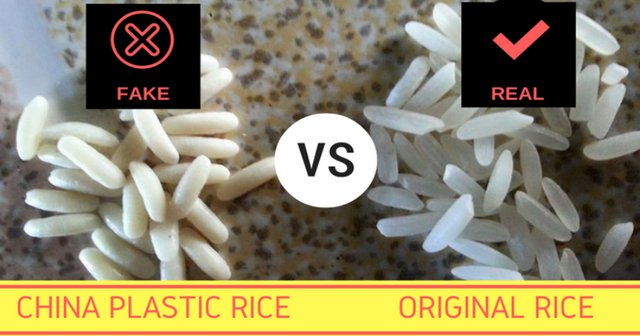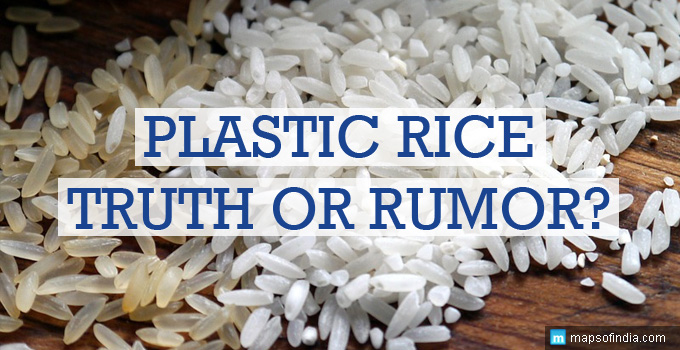White rice, how about Plastic rice!!
What is rice? Real Rice!

Rice is a grain, the seed of a type of grass, which is the most widely grown and the most important source of dietary carbohydrate on Earth. Generally grown in flooded paddy fields to keep predators at bay, it can also be grown in soil but then requires much more human intervention and pest control. It is said there are almost 50,000 varieties of rice and more are being created every year by cross-breeding. In China, which produces about 25 per cent of all rice, some varieties ripen so quickly that two or even three crops a year can be harvested.
Half of the worlds 7 billion population eat rice as a staple with 90% of that being consumed in Asia. White rice for the most part is the most consumed rice in the world, however this rice provides almost no nutritional value as the husks have all been removed. It is very starchy and contributes to type two diabetes as the sugars contained in it are absorbed into the body very quickly.
Rice may be cooked and eaten as a high-fibre, high-nutrition wholegrain, often called brown rice, or might be husked and then served as white rice, which is less nutritious and has no fibre content.
A few rice families have distinct and attractive fragrances and flavours, but most rice is chosen to be bland so it can be cooked, served and eaten as a filling accompaniment to tastier foods.
When ground and added to a hot liquid, white rice acts as a thickener.
Here are some of the rice choices:
Arborio, Basmati, Black rice, Bomba, Brown rices, Calasparra, Carolina, Jasmine, Fragrant rice, Glutinous rice, Paella rice, Par-boiled rice, Patna, Pilaf rices, Pudding rice, Risotto rice, Sticky rice, Sushi rice, White rice, Wholegrain rice, Wild rice:
And now to the Plastic rice!

Originating in China, rumours on social media have circulated since about 2010 of plastic rice being manufactured and mixed in with the real rice supply in order to trick consumers. The rumours were originally prompted by "fake rice" scandals, although they didn't involve food made entirely out of plastic.
In one case, companies were passing off ordinary but edible rice as premium "Wuchang" grains. Then in 2011, reports emerged that rice was being produced with potatoes and an industrial sticky resin. The rumours were further compounded when a Chinese restaurant association official warned that eating three bowls of "plastic rice" was the equivalent of eating one plastic bag.
At no point, however, were there confirmed cases of large amounts of plastic chips being passed off as rice. "Plastic rice" is manufactured for use in shipping boxes, but it's likely that in most cases the cost of the chips would actually be more expensive than real rice.
Despite little evidence that it's a widespread problem, rumours of "plastic" rice being sold in Africa and elsewhere persist on social media - driven in particular by viral videos which show bouncing rice balls.
The story had reached social media in Africa by 2016 when Nigerian customs authorities confiscated 2.5 tonnes of rice. Customs officials initially claimed that the rice was plastic - and were later forced to backtrack when the country's health minister said there was no evidence for the claims. Tests showed that the rice did however contain a high level of bacteria, Nigeria's National Agency For Food and Drugs said.
The rumours have spread over the last few months in Senegal, The Gambia and Ghana - and reached such a pitch that the Ghana Food and Drugs Authority decided to carry out an investigation.
They invited consumers and traders to submit samples of any rice brands they suspected of being made of plastic - and eventually concluded that there was no plastic rice being sold on the Ghanaian market.
But rumours have persisted that plastic is being sold as rice, fuelled by videos which show people bouncing rice balls. Some also purport to show how the rice is made in factories.
Alexander Waugh, director of the Rice Association, a UK-based industry group, says the videos may be authentic - but not because the grains are plastic. Rice - when prepared in the right way - can actually bounce, Waugh told BBC Trending radio.
"The natural characteristics of rice are carbohydrates and proteins and you can do something like that with rice," Waugh says.

Take a look at these videos and you decide!
So you decide, True or false! Your comments appreciated.
Cheers and God Bless.